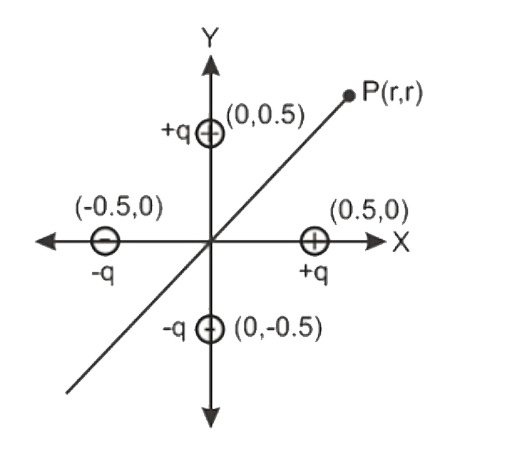Three point charges +q, –2q and +q are placed at points (x = 0, y = a, z = 0), (x = 0,y = 0, z = 0) and (x = a, y = 0, z = 0) respectively. The magnitude and direction of the electric dipole moment vector of this charge assembly are:-
√2 qa along +x direction
√2 qa along + y direction
√2 qa along the line joining points (x = 0, y = 0, z = 0) and (x = a, y = a, z = 0)
qa along the joining points (x = 0, y = 0, z = 0) and (x = a, y = a, z = 0)
The correct Answer is:C
Step by step video, text & image solution for Three point charges +q, –2q and +q are placed at points (x = 0, y = a, z = 0), (x = 0,y = 0, z = 0) and (x = a, y = 0, z = 0) respectively. The magnitude and direction of the electric dipole moment vector of this charge assembly are:- by Physics experts to help you in doubts & scoring excellent marks in Class 12 exams.
Updated on:21/07/2023Topper's Solved these Questions
- ELECTROSTATICSBOOK - MOTIONCHAPTER - ELECTROSTATICSEXERCISE - Exercise -3 Section (B) Previous Year Problems | JEE Main
30 Videos
- ELECTROSTATICSBOOK - MOTIONCHAPTER - ELECTROSTATICSEXERCISE - Exercise - 2 (Objective Problems | NEET)
64 Videos
- ELECTRONICS - SEMI CONDUCTORBOOK - MOTIONCHAPTER - ELECTRONICS - SEMI CONDUCTOREXERCISE - EXERCISE - 3
29 Videos
- ELECTROSTATICS - I BOOK - MOTIONCHAPTER - ELECTROSTATICS - I EXERCISE - EXERCISE - 4 (Level -II) PREVIOUS YEAR - JEE ADVANCED
13 Videos
Similar Questions
Two charges +q and -q are kept at (−x1,0)and(x1,0) respectively in the x-y plane. Find the magnitude and direction of the net electric field at the origin (0,0)
View Solution" Two point charges "+2q" and "-q" are placed on "x" -axis at "(0,0,0)" and "(3,0,0)" respectively,How many points of zero electric potential are there in the plane "X=5?
View Solution
Knowledge Check
The point charges +q,2q and +q are placed at point (x=0,y=a,z=0),(x=0,y=0,z=0) and (x=a,y=0,z=0), repectively. The magnitude and direction of the electric dipole moment vector of this charge assembly are
A√2qa along + y directionB√2qa along the line joining points
(x=0,y=0,z=0) and (x=a,y=a,z=0)Caq along the line joining points
(x=0,y=0,z=0) and (x=a,y=a,z=0)D√2qa along + x directionThree charged particles having charges q, -2q & q are placed in a line at points (-a, 0), (0,0) & (a , 0) respectively. The expression for electric potential at P(r, 0 ) for r >> a is
A14πε0qa2r4B14πε02qa2r3C14πε04qa2r2D14πε08qa2rThree charges -1, +q and +q are situated in x-y plane at points (0, -a)(0,0) and (0, a) respectively. The potential at a point distant r(r>a) in a direction making an angle θ from y - axis will be
AkqrBkqr2(2acosθ)Ckqr(1+2acosθr)Dkqa
Two charges - q and +q are located at points (0, 0, - a) and (0,0, a), respectively.
What is the electrostatic potential at the points (0, 0, z) and (x, y,0) ?
View SolutionAsserions: Two points charges +Q and −Q are fixed at point A(+a,0,0)and point B(−a,0,0) respectively.Then the magnitude of electric flux due to electric field of either point charge through infinite y-zplane (that is x=0 plane) is less than magnitude of net electric flux due to electric field of both charges through that plane (x=0 plane)
Reason :the magnitude of the net electric flux through a surface due to a system of point charges is equal to sum of magnitude of electric flux through that surface due to each of the point charge of the system.
View SolutionPoint charges +4q,−q and +4q are kept on the x-axis at points x=0,x=a and X=2a respectively, then
View SolutionFour charges +q,+q−q, and -q are placed on X - Y plane at the points whose coordinates are (0.5,0),(0,0.5),(−0.5,0)and(0,−0.5) respectively.

The electric field due to these charges at a point P(r,r), where r>>0.5, will be
View SolutionTwo point charges −q and +q are located at points (0,0−a) and (0,0,a) resepctively.The electric potential at point (0,0,z)is (Z>a)
View Solution
